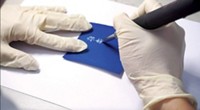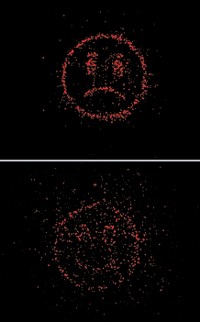Advertisement
Grab your lab coat. Let's get started
Welcome!
Welcome!
Create an account below to get 6 C&EN articles per month, receive newsletters and more - all free.
It seems this is your first time logging in online. Please enter the following information to continue.
As an ACS member you automatically get access to this site. All we need is few more details to create your reading experience.
Not you? Sign in with a different account.
Not you? Sign in with a different account.
ERROR 1
ERROR 1
ERROR 2
ERROR 2
ERROR 2
ERROR 2
ERROR 2
Password and Confirm password must match.
If you have an ACS member number, please enter it here so we can link this account to your membership. (optional)
ERROR 2
ACS values your privacy. By submitting your information, you are gaining access to C&EN and subscribing to our weekly newsletter. We use the information you provide to make your reading experience better, and we will never sell your data to third party members.
Materials
Printing Without Ink
Consumers will soon get digital prints in an instant, thanks to organic dyes
by Bethany Halford
September 10, 2007
| A version of this story appeared in
Volume 85, Issue 37

POINT, SHOOT, and print. Soon, photographers in even the most remote corners of the globe will be able to do just that and get instant prints of their digital photos. The secret to getting these snapshots in a snap lies in some clever chemistry developed at Zink Imaging, a company based in Waltham, Mass.
Scientists at Zink—which is short for zero ink—have come up with a photo printing process that requires no ink. The key to "photos on the go" lies within Zink's thermally activated photo paper.
Direct thermal printing, the basis for the new photo printer, has been around for about 50 years. It was originally developed—and is still used—to print cash-register receipts. The cash register uses a special paper that's loaded with an indicator dye in its colorless form and small particles of a solid acid, usually a phenol.
The cash register's print head is made up of a row of hundreds of tiny heaters, each of which can heat independently to form patterns. When the energized heaters contact the paper, they melt the acid, which then protonates the indicator, leaving a dark mark on the paper.
This printing process has a number of advantages, according to John L. Marshall, a chemist with Zink who described the work last month in a Division of Organic Chemistry session at the American Chemical Society national meeting in Boston. The equipment for the printing process is inexpensive and rugged, and it requires moving parts only to advance the paper through the print head. There are no bulky ink cartridges or internal "plumbing," so Zink was able to shrink the basic components for a photo printer down to about the size of an iPod.
The challenge for the chemists at Zink was to figure out a way to get full-color prints from what has usually been a monochromatic process. The traditional indicator dye plus acid formulations either took too much time to develop color or weren't stable enough to maintain color, Marshall said. So the Zink researchers sought an alternative chemical transformation to create color—a phase transition.
"Because we use precisely tuned thermal pulses, we required a system that would generate color from heat very quickly, within fractions of a millisecond," Marshall explained. He and his colleagues reasoned that an indicator dye containing a tautomerizable hydrogen might be coaxed into crystallizing in a colorless form, Marshall told C&EN. Upon melting, the compound would tautomerize to a colored form.

"INITIALLY, WE investigated the fluoran class of indicator dyes, which are colorless in the ring-closed lactone form and colored in the ring-opened carboxylic acid form," Marshall explained.
"In the course of screening experiments, we discovered that fluorescein benzyl ether, although crystallizable as a colorless solid, turned yellow upon melting. The amount of yellow color was small, only about 3% of the color expected from complete conversion of the dye to the colored form, but it was still a promising lead," Marshall told C&EN.
From there, Marshall said, they treated the dye as a medicinal chemistry team would treat a promising drug lead. They manipulated the compound's functional groups to tune the dye's properties, such as degree of coloration, melting point, glass transition temperature, hue, and photochemical stability.
With a yellow dye in hand, the Zink chemists sought magenta and cyan dyes with similar properties so that, through color mixing, they could access the entire spectrum. For these, they found that rhodols and rhodamines, respectively, gave the desired colors and properties, after structural optimization.
To create the photo paper, the colorless microcrystals are put down on the paper in discrete layers and covered with a clear finish. Each color has a different melting point, so creating the proper color at each pixel works by what Marshall described as the "baked alaska" principle.
A very hot oven will brown the outer meringue of a baked alaska while leaving its inner core of ice cream solid. Likewise, a short, hot pulse can transform the high-melting yellow crystals of the paper's top layer, while the other two layers remain crystalline. A longer burst of low heat melts only the cyan crystals on the bottom layer due to their lower melting point. An intermediate pulse of heat will melt crystals in the middle magenta layer while leaving the other two layers in the solid form.
The printer creates a full palette of colors via a rapid succession of pulses from its tiny heaters, each of which melts just enough of each crystalline layer to produce the proper shade. Because the crystals soften at a high temperature—somewhere around 80 oC for the lowest-melting crystals—the images have high color stability.
"It's interesting technology," said Ron Glaz, an analyst and director of the digital imaging program at the Framingham, Mass.-based research firm IDC. "It's unique in the fact that there are no cartridges involved for consumers to replace." Glaz added, however, that he thinks that because the prints are somewhat pricey, the technology is unlikely to usurp desktop printers and will probably be limited to a niche market.
Scott Wicker, chief marketing officer for Zink, says 2- by 3-inch sheets of the photo paper will sell in packs of 10 for about $2.00 per pack. A handheld printer using the technology should be available around the end of the year for between $79 and $129.
Users will be able to transmit photos to the printer directly from cell phones or cameras via Bluetooth or through a USB connection. A printer integrated with a digital camera should also be available for less than $250.





Join the conversation
Contact the reporter
Submit a Letter to the Editor for publication
Engage with us on Twitter